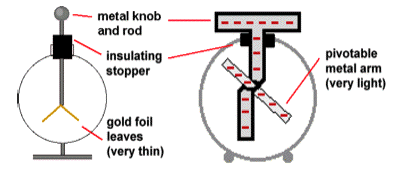
Teaching Physics with the Physics Suite
Home | Action Research Kit| Sample Problems | Resources | Product Information
Problems Sorted by Type | Problems Sorted by Subject | Problems Sorted by Chapter in UP
 |
Teaching Physics with the Physics Suite
Home | Action Research Kit| Sample Problems | Resources | Product Information |
Problems Sorted by Type | Problems Sorted by Subject | Problems Sorted by Chapter in UP |
In the figure below are shown schematics of two versions of an electroscope: a historic version on the left with gold foil leaves, and a more modern one with a pivoting metal arm on the right.

(a) The charged metal disk of an electrophorus is touched to the metal knob
of the electroscope and removed. The movable leaves of the electroscope, which
hung straight down when the electroscope was uncharged, now stand apart as
shown in the two figures above. Explain why this happens, tell what sign of
charge you think the electroscope has, and why you think so.
(b) The electroscope is neutralized by touching the knob. Now the charged
metal disk of the electrophorus is brought near to the knob but doesn’t
touch it. The leaves separate. Explain why.
(c) While the disk of the electrophorus is near to the electroscope’s
knob (but not touching) the knob of the electroscope is touched with a finger
and then the electrophorus disk is taken away. The leaves stand out again.
Explain why this happens, tell what sign of charge you think the electroscope
has, and why you think so.
Not finding what you wanted? Check the Site Map for more information.
Page last modified February 11, 2006: E27